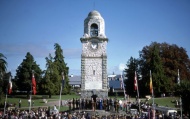Articles
Regional rugby

The passion and parochialism of provincial rugby has helped give the game a special place in New Zealand’s social and sporting history. Read brief histories, highlights and quirky facts about each of New Zealand's 26 regional rugby teams.
- Page 22 - Tasman rugbyHistory and highlights of rugby in the Tasman
Largest centre of Marlborough, Blenheim was established in the 1850s as ‘the Beaver’, a settlement as waterlogged as the name implied. The 1855 earthquake deepened the Ōpawa River, making it navigable for sea-going vessels. Two traders, James Wynen and James Sinclair, set up in business. As 150-acre (60-hectare) lots were subdivided, Sinclair traded profitably in them. Farming contributed to the growth of Blenheim’s population, and Blenheim replaced Picton as Marlborough’s capital in 1865. The Wairau River dominates the plains around Blenheim – and its waters have sometimes flooded the town. But it is also the source of the free-draining stony soils that have proved ideal for growing grapes for wine, leading to international success for Marlborough sauvignon blanc. Over 20,000 hectares of the region are planted in vineyards.




